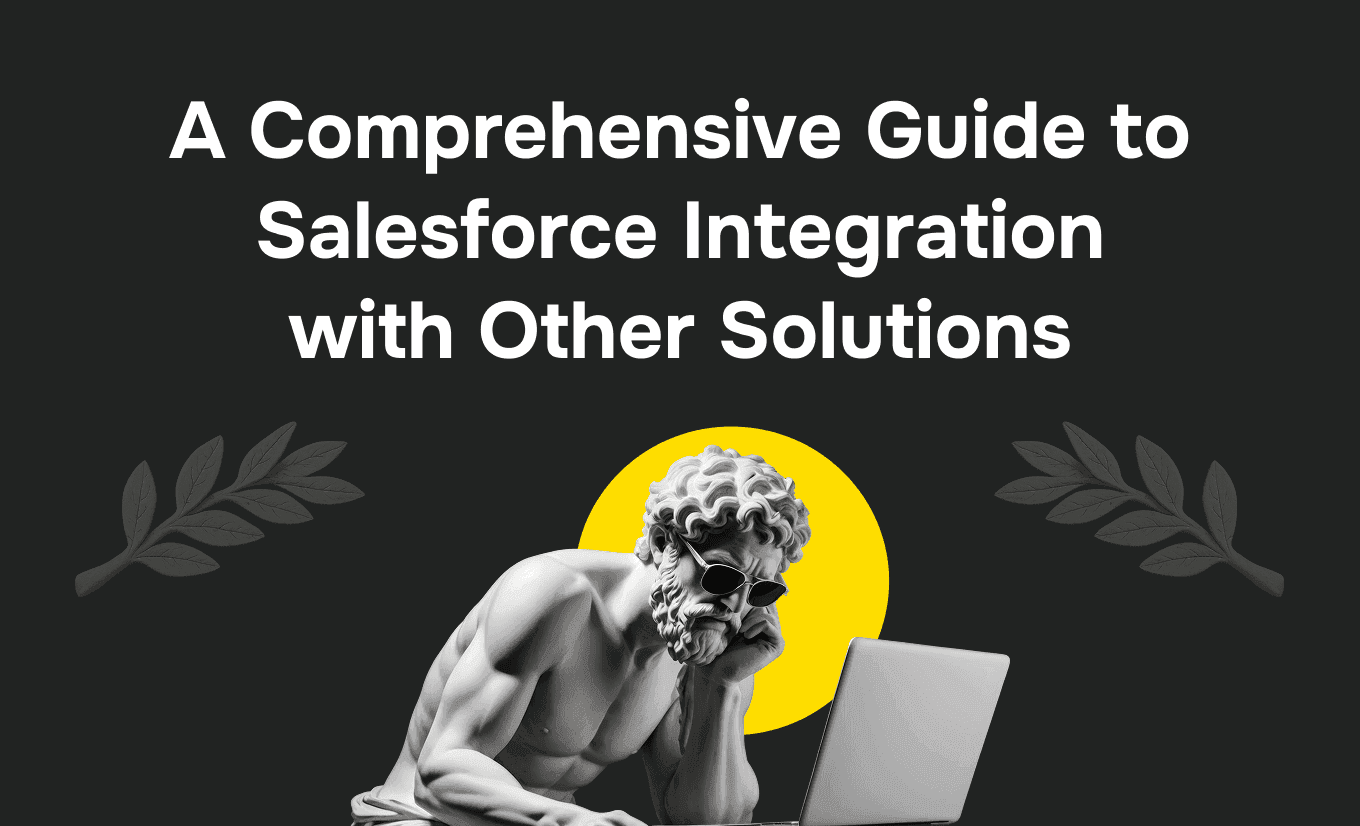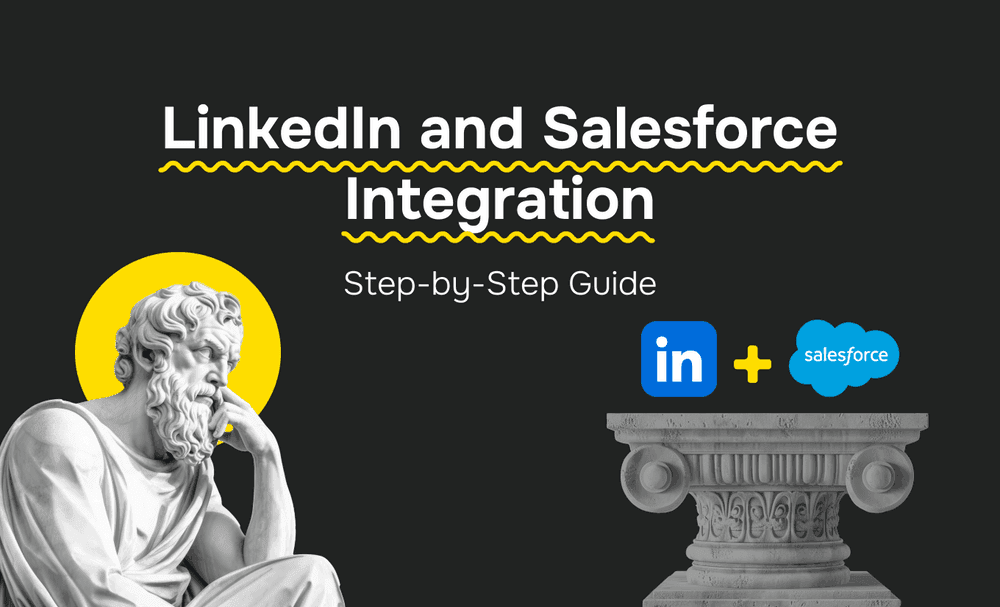Salesforce integrations with tools like Slack, QuickBooks, and Jira streamline communication, automate data sharing, and enhance data capture, accelerating issue resolution and giving your business a clear competitive advantage. By unifying sales, finance, and support workflows within Salesforce, your teams close deals faster and deliver superior customer service without switching platforms.
For example, instead of juggling separate inventory and CRM systems, a manager can instantly access real-time stock data and collaborate internally, speeding up responses and boosting customer satisfaction. This seamless integration drives measurable ROI through faster sales cycles, reduced manual work, and improved client loyalty, making the investment in Salesforce integration services a strategic move to grow your business.
What is Salesforce Integration?
Salesforce integration is a way of bringing together two or more systems, including external objects, to optimize workflows. This way, you don't have to jump from platform to platform. Instead, you get a unified and structured experience across multiple apps, which is particularly important for all business teams.
Why Integrate Salesforce with Other Solutions?
In addition to ease of use, you can expect other prominent benefits to give your business a new lease of life.
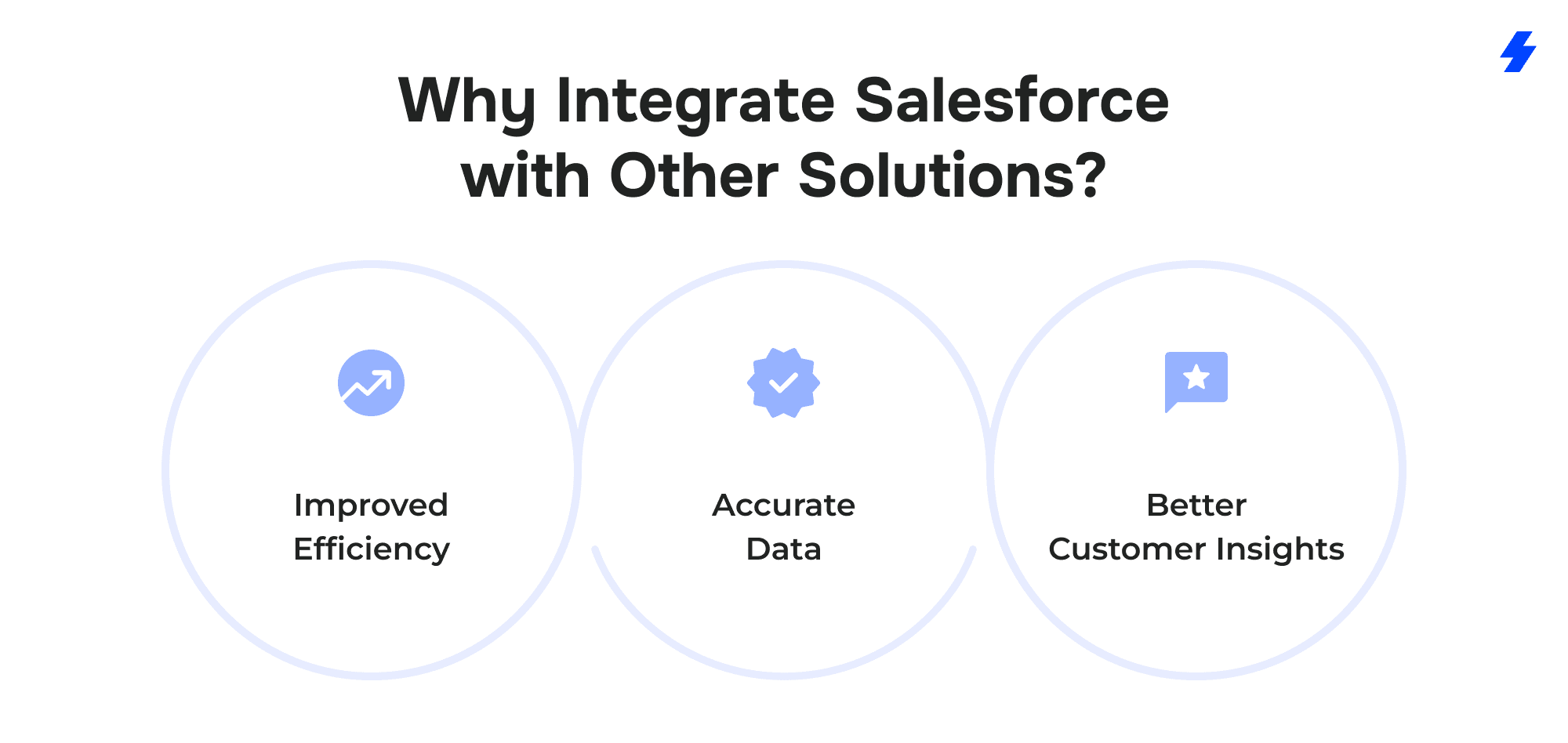
Improved efficiency
Working with data from both Salesforce and external systems is usually time-intensive. Moreover, the process may be hampered by a large volume of documents, different formats and data structures, lack of data synchronization, varying levels of security on platforms, etc.
Salesforce integrations with other products free users from these difficulties, providing a single place to manage data, workflows, and clients. Thus, you have more time to focus on your critical missions.
Moreover, Salesforce Data Sync and AppExchange integration apps ensure smooth synchronization across platforms.
Accurate data
As we know, inaccurate data can lead to poor business decisions and strategies, potentially leading to missed opportunities, but utilizing pro code tools can help mitigate these risk. Moreover, it can undermine customer trust and satisfaction, causing reputational damage.
As information transfers between Salesforce and external systems, it undergoes automatic validation and conversion based on predetermined standards. Thus, you get accurate and consistent data. In addition, administrators get alerts if any data inconsistencies are identified, enabling them to fix the issue promptly and maintain the overall data integrity.
Better customer insights
Poor customer understanding can lead to misguided marketing campaigns and inappropriate product development efforts, resulting in wasted resources and time.
Fortunately, companies can efficiently gather and analyze customer data from diverse sources with Salesforce integration solutions. This view comprehensively explains customer behaviors, preferences, and needs. Furthermore, it equips businesses to personalize their interactions, fine-tune marketing strategies, and enhance customer satisfaction and loyalty. Therefore, Salesforce integrations are helpful for any organization seeking to optimize customer relationship management.
This is how you can improve your business in terms of efficiency, data management, and customer engagement when you integrate Salesforce with other products. Now, let’s explore the various tools and methods for integrating Salesforce with other systems to streamline your workflows
How Salesforce Integration Impacts Key Teams
Sales Teams: Integration accelerates sales cycles by providing real-time access to accurate customer and product data, reducing manual entry, and enabling reps to close deals more efficiently.
Marketing Teams: Unified data enables precise targeting, improved lead nurturing, and better campaign performance through consistent, actionable customer insights across platforms.
Customer Support Teams: Connected systems empower support agents with a full customer history and product information through outbound integration, enabling faster resolutions and higher satisfaction rates.
Long-Term Benefits of Salesforce Integration
Beyond immediate gains, business logic integration streamlines operations by automating workflows and reducing errors. It supports data-driven decision-making that improves sales velocity, enhances customer retention, and boosts satisfaction metrics. Over time, these improvements reduce operational costs and foster cross-team collaboration, turning your Salesforce platform into a strategic asset that drives sustainable growth.
Types of Salesforce Integration
Generally, there are three most common Salesforce integration patters: point-to-point, hub-and-spoke, and Enterprise Service Bus integration.
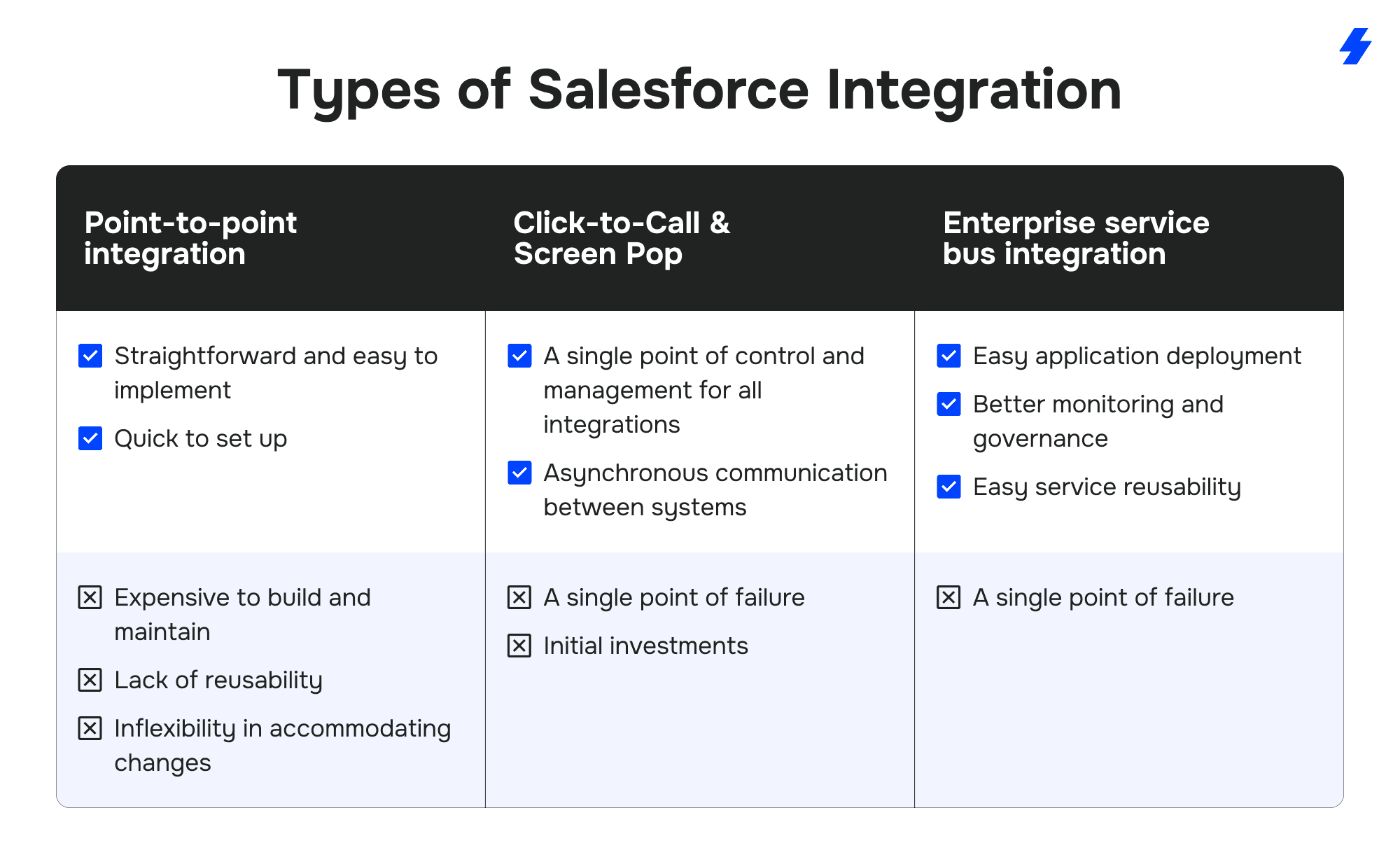
1. Point-to-point integration
Point-to-point system integration, also referred to as one-to-one integration, involves the transmission of messages between systems through a 1-1 relationship. For instance, consider a sales application that sends new order information to a billing system, a shipping application, and a tracking system, each as a distinct integration. If you require the shipping and tracking systems to communicate with each other, an additional integration must be set up.
Pros
✔ Straightforward and easy to implement
✔ Quick to set up
Cons
❌ Expensive to build and maintain
❌ Lack of reusability
❌ Inflexibility in accommodating changes
When to choose it:
Point-to-point integration works well for smaller businesses or simpler environments where only a few systems need to connect without complex workflows. For example, integrating Salesforce with QuickBooks for basic invoice syncing is often done via point-to-point connections due to its straightforward nature.
2. Hub-and-spoke integration
This integration method involves a centralized system that serves as a hub for facilitating communication between other connected systems. This hub is responsible for routing all traffic, thus eliminating the need for multiple connections for point-to-point integration.
Pros
✔ A single point of control and management for all integrations
✔ Asynchronous communication between systems
Cons
❌ A single point of failure
❌ Initial investments
When to choose it:
Hub-and-spoke suits organizations looking to centralize integration management and improve scalability. It’s often used when integrating Salesforce with multiple collaboration tools like Slack and Jira, allowing seamless communication between different platforms via the hub.
3. Enterprise service bus integration
The Enterprise Service Bus (ESB) is a more evolved version of the hub-and-spoke integration architecture model. ESB uses a powerful integration engine to establish connections between various software applications and systems. ESB is particularly useful if you need to manage your 'messages' in a certain way.
For example, if you need to route a message from one system to another or multiple systems, ESB can help you achieve this. Additionally, it can assist you if you need to orchestrate the order of transactions. For instance, you may require a series of events to occur in a specific order, and ESB can ensure that these events occur according to your desired sequence.
It can also transform messages from one system to another, especially if the destination system doesn't speak the same language as the source system. Finally, this architecture can provide robust security features, including authentication and authorization, to ensure your system meets all necessary security requirements.
Pros
✔ Easy application deployment
✔ Better monitoring and governance
✔ Easy service reusability
Cons
❌ A single point of failure
When to choose it:
ESB integration is ideal for large enterprises with complex IT landscapes that require advanced message routing, orchestration, and transformation capabilities. Organizations integrating Salesforce with a suite of enterprise applications, including ERP systems and multiple marketing automation tools, benefit from ESB’s flexibility and governance. For example, orchestrating data flows between Salesforce, Jira, Slack, and QuickBooks in a large enterprise environment is best handled with an ESB.
Salesforce Integration Patterns
Integrating with other apps is essential when using Salesforce, but each scenario is unique. Developers must address common requirements and challenges by following specific design patterns.
Remote Process Invocation
A process is started by Salesforce in a remote system using this pattern. However, unlike the request-and-reply pattern, Salesforce does not wait for the process to complete. Instead, the remote process receives a request from Salesforce, and when the request is accepted, Salesforce regains control.
Batch Data Synchronization
Data saved on the Salesforce Lightning platform is refreshed or created to reflect modifications transferred to an external system. The updates are carried out in batches in both directions.
Remote Call-in
A remote system can manage data stored on the Salesforce Lightning platform through a call-in method, which enables the creation, retrieval, updating, and deletion of the data.
User Interface Update Based on Data Changes
The Salesforce user interface should be updated automatically due to changes in Salesforce data.
Data Virtualization
Real-time access to external data is available in Salesforce, eliminating the need to store data in Salesforce and then match it up with data from another system.
Common Salesforce Integration Scenarios
Whether you're a Salesforce amateur, an IT professional, or a business leader with an eye on innovation, the following integration possibilities will open new doors of opportunity in your quest for success.
Salesforce and Project Management Tools Integration
Although Salesforce is the top-rated CRM software globally, it has some limitations for project management. Nevertheless, users have found ways to make the Salesforce platform more efficient by easily integrating it with the right services.
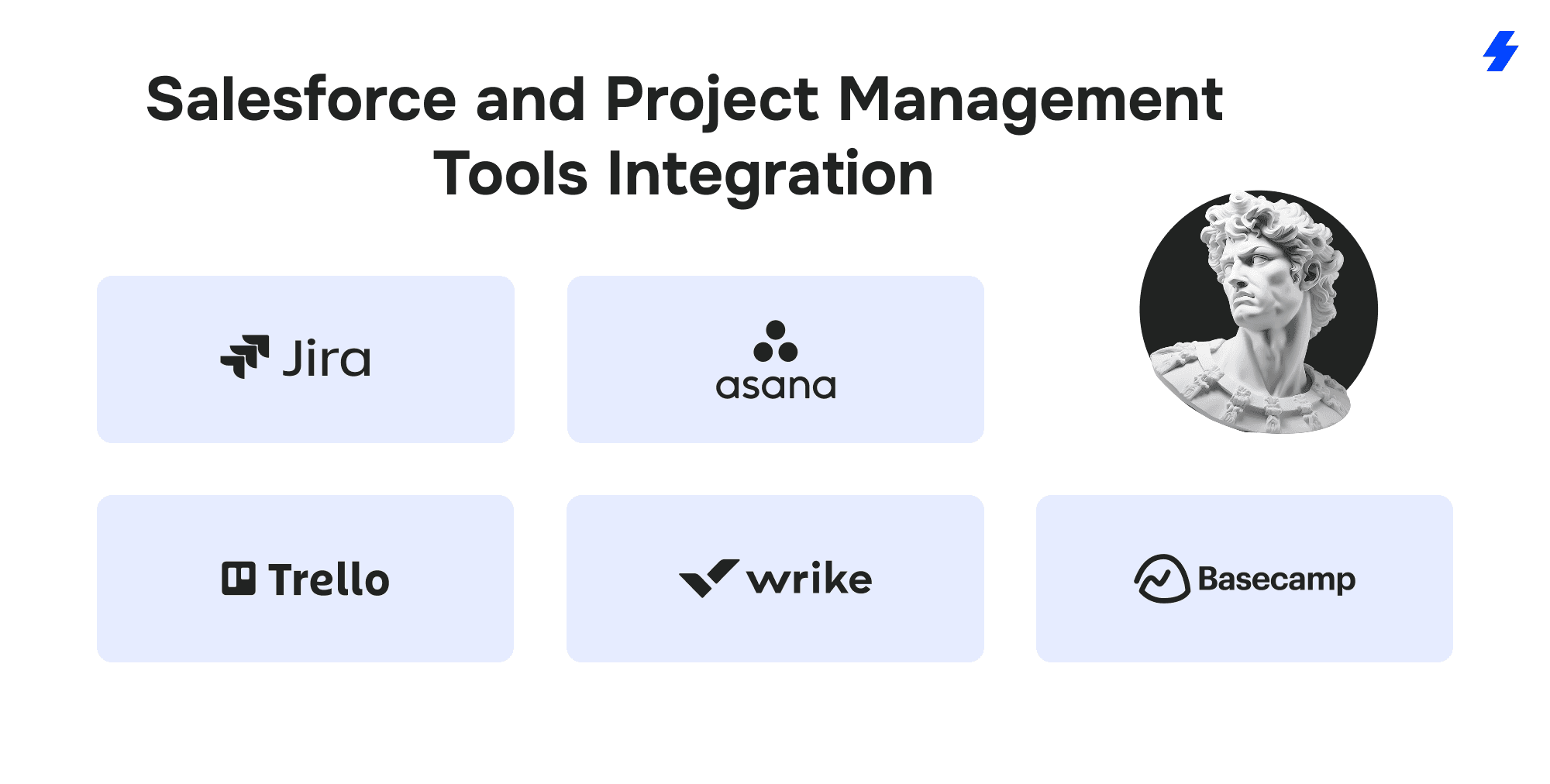
Jira
Helps teams optimize and speed up business processes with automation and a drag-and-drop interface. For example, a software company integrating Jira with Salesforce reduced issue resolution time by 20%, accelerating customer onboarding and support workflows.
Asana
Asana offers an intuitive task management system suitable for teams of all sizes and supports data virtualization for enhanced integration with Salesforce. What sets Asana apart is its ability to integrate with other tools like Salesforce, making it an even more efficient and streamlined solution.
Trello
Trello is a popular app for managing projects based on the Kanban method. One of its key features is the ability to organize tasks into three columns: To-do, Doing, Done. Thus, users can quickly move cards between these columns and add notes, voice recordings, or images. So, thanks to these features, Trello simplifies collaboration between team members and external partners.
Wrike
Wrike's various project management and productivity tools make collaboration with teams easier. In particular, it enables the project manager to create comprehensive plans and assign tasks to respective team members. Wrike's prominent feature is Project Risk Prediction, which helps prevent missing deadlines. Notably, integration with Salesforce further enhances the functionality of the app.
Basecamp
Basecamp offers collaboration tools and project management software. Its ability to adapt to different team structures and transparent pricing makes it a popular choice for big-team companies. By facilitating communication and coordination among team members, Basecamp significantly streamlines project management.
BOFU impact: Companies integrating Jira or Asana with Salesforce commonly experience improved project delivery speed and enhanced cross-team transparency, which directly supports faster sales cycles and higher client satisfaction.
Salesforce and Marketing Automation Tools Integration
The benefits of marketing automation tools themselves can hardly be overestimated. But when you connect Salesforce with them, the value increases even more. Specifically, your company can attract the best prospects, follow up and keep them engaged, and reach out to them at the right time to ensure the best deals for you.
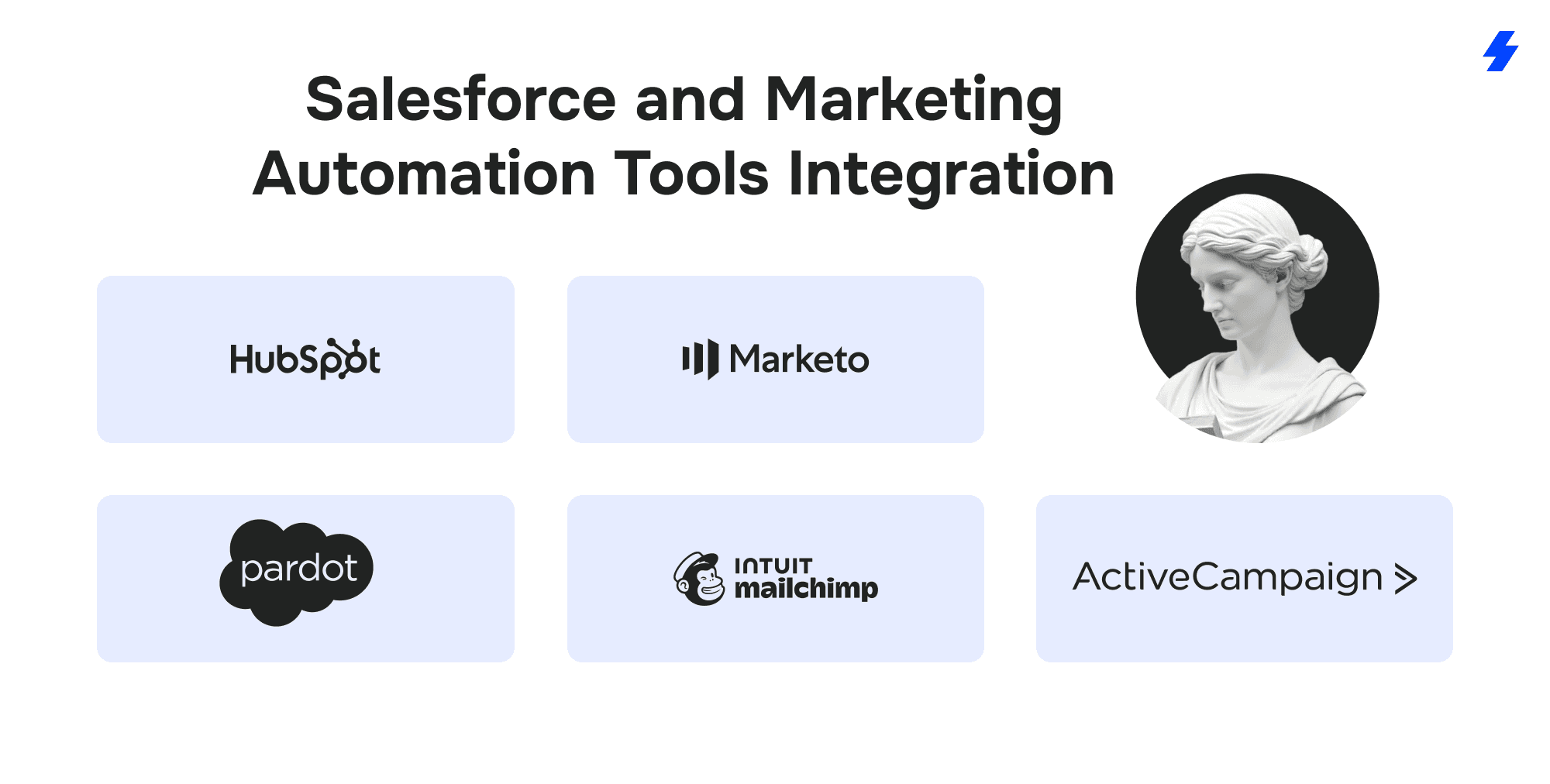
HubSpot
HubSpot is one of the most widely used tools for automating monotonous marketing work. Salesforce integration with HubSpot helps users streamline lead management, take their marketing campaigns to the next level, and keep perfect consistency between marketing and sales.
Marketo
Marketo is a powerful marketing automation program, but combining it with Salesforce CRM creates better opportunities to recognize and reach more targeted customer audiences. For example, the Marketo Salesforce combination provides accurate data integration, better alignment between sales and marketing teams, and highly personalized and targeted marketing campaigns.
Pardot
By integrating Salesforce with Pardot, businesses can enjoy various advantages, such as streamlined lead generation and nurturing processes, in-depth analytics and reporting for informed decision-making, and better measurement of marketing efforts. Plus, Pardot offers a range of other features, including lead scoring and email marketing, which can drive business growth.
Mailchimp
Mailchimp is a widely used email marketing automation tool that offers a range of features to help businesses streamline their marketing efforts. One of the key benefits of Mailchimp Salesforce integration is the ability to automate email marketing campaigns, saving you time while improving your results.
Additionally, Mailchimp's contact segmentation and reporting features can help better understand the audience and optimize messaging.
ActiveCampaign
Like other tools, this one offers marketing automation capabilities that help you automate critical tasks and workflows. However, some of the ActiveCampaign Salesforce integration highlights include lead scoring for identifying the most promising leads and prioritizing your efforts accordingly. Additionally, ActiveCampaign offers advanced reporting features that track your progress and identify areas for improvement so you can continually refine your marketing strategy and achieve goals.
BOFU impact: Businesses using Pardot or Marketo integrated with Salesforce often report significant improvements in qualified leads and conversion rates, helping reduce customer acquisition costs and accelerate pipeline velocity.
Salesforce and E-commerce Tools Integration
Salesforce e-commerce integration combines customer data and purchase history, allowing businesses to personalize marketing efforts and recommendations, increasing the likelihood of repeat purchases. Thus, analyzing customer behavior and preferences helps create a seamless and engaging shopping experience that encourages customers to return and build long-term relationships with a brand.
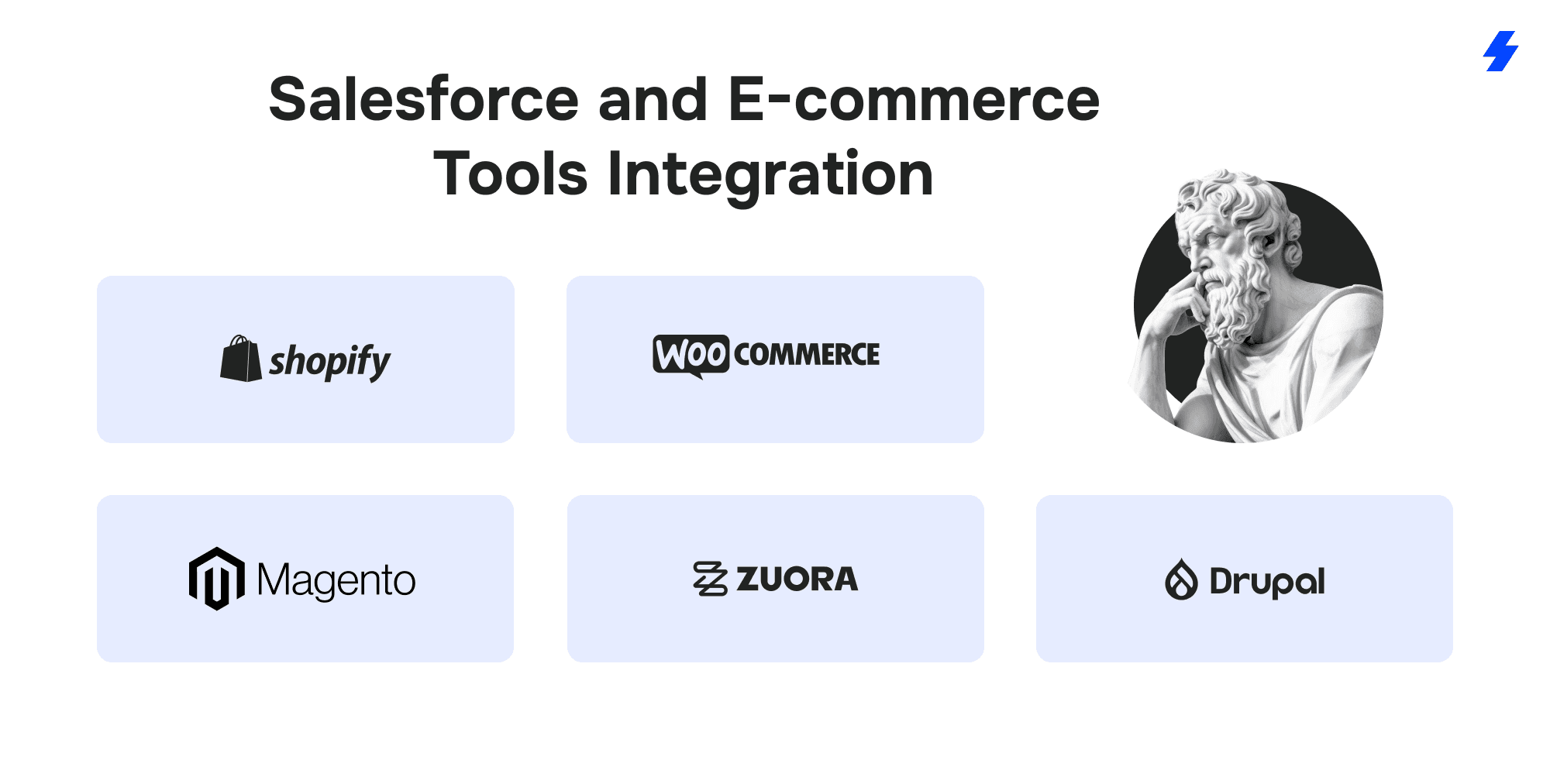
Shopify
Shopify is a widely recognized e-commerce solution suitable for small startups and established enterprises, offering a user-friendly setup process for online stores that leverages the REST API for smooth Salesforce integration. The platform provides diverse themes to help users create a polished and appealing storefront. However, integrating Shopify with Salesforce strengthens its potential for executing creative marketing strategies.
WooCommerce
WooCommerce enables the transformation of a regular WordPress site into a comprehensive e-commerce venture, and the best part is that it doesn't come with any cost. Tasks like product addition, payment gateway setup, and theme selection are relatively uncomplicated for those well-acquainted with WordPress. Additionally, WooCommerce extends support for numerous plugins and extensions, including integrating WooCommerce with Salesforce.
Magento
Magento is a perfect e-commerce solution for well-established enterprises or those poised for growth, as it offers features essential for online stores. Configuring Magento is relatively straightforward, even if you need more technical expertise. Also, Magento accommodates Salesforce integration, making it an appealing choice for businesses seeking smooth connectivity.
Zuora
Zuora provides various solutions tailored for businesses operating under the subscription model. Its primary component, Zuora CPQ, streamlines payment processes, boosts customer retention and has been instrumental in the growth of numerous major corporations. When integrated with Salesforce, Zuora's connection with this leading CRM system ensures seamless data integration and management.
Drupal
Drupal is a content management framework that drives numerous prominent websites. It offers the Drupal Commerce extension, facilitating the creation of online stores within Drupal 8 websites. Integrating this tool with Salesforce improves the customer shopping experience thanks to cross-channel consistency, efficient order management, and highly personalized content and product recommendations.
Key Metrics to Track Post-Integration Success
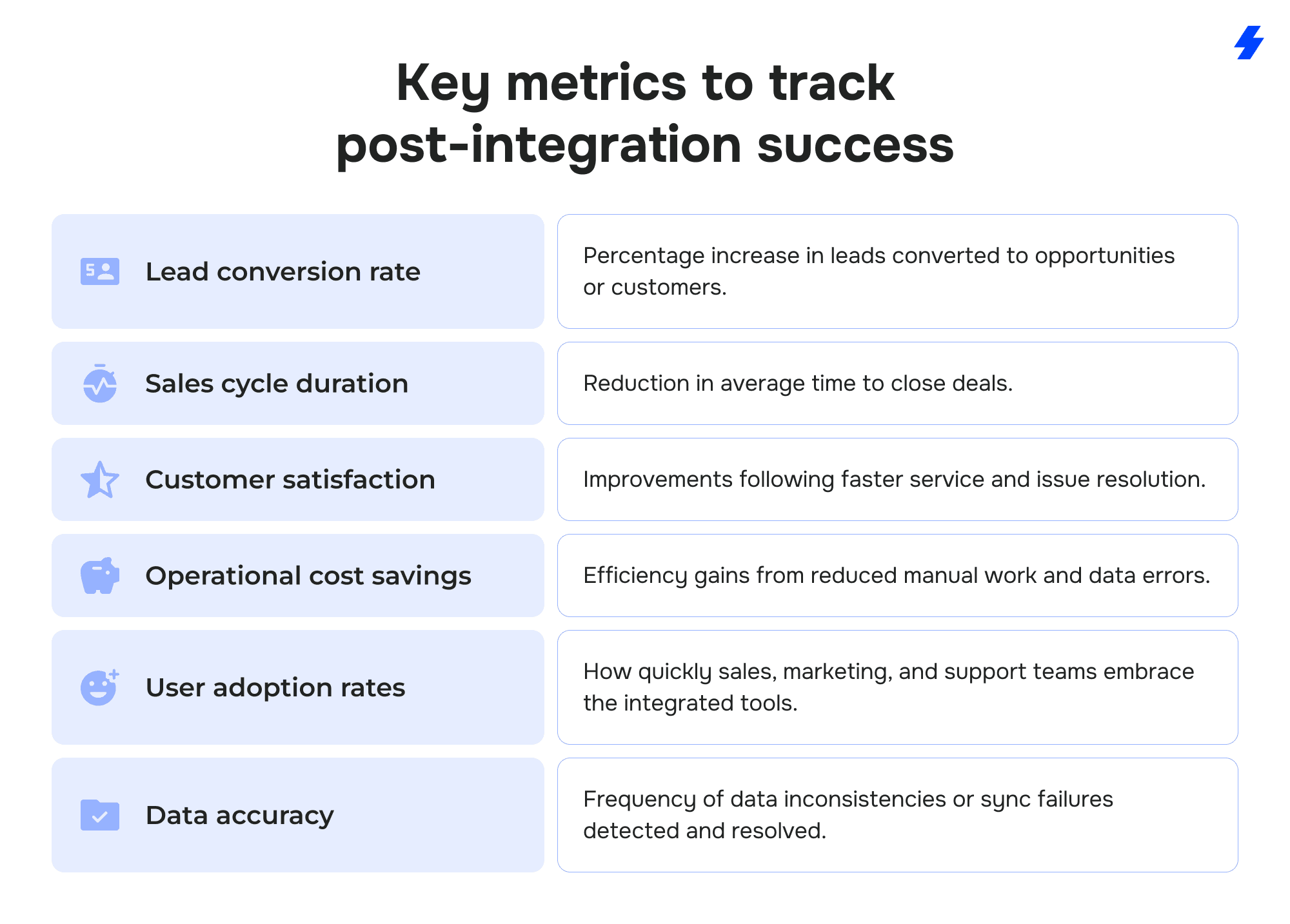
How Do You Integrate Salesforce CRM With Other Products?
If you will integrate Salesforce with other solutions and need assistance, a few options are available. For example, you can work with Salesforce consultants. These professionals specialize in integration services and can assess your needs, recommend the right solutions, and implement them.
Another option is to rely on your in-house IT team if you have one. They can handle integration projects with expertise in Salesforce and integration technologies. Just make sure they have the necessary knowledge and experience for a successful Salesforce integration.
Lastly, you can hire independent freelancers. Websites like Upwork and Freelancer allow you to find skilled professionals for specific integration projects. However, it can be cost-effective if you only need help with a particular integration task.
Whoever conducts Salesforce integration must do it consistently. Check our step-by-step instructions below.
9 Steps to Make Salesforce Integrations Perfect

Step 1. Create a Salesforce integration project plan
To begin, it's important to create a project plan for Salesforce integration. This plan should ensure that the integration supports your business objectives, resolves issues, and provides more benefits than difficulties. Identify the fundamental requirements for the integration, such as adaptability, expandability, and ease of use.
Step 2. Set the budget and resources
After establishing your expectations and objectives, it is essential to determine what level of Salesforce integration is possible within your available resources, skill set, and financial means.
Step 3. Find a Salesforce integration consultant
If your team lacks the necessary knowledge and skills to integrate CRM systems with tools, seeking guidance from a Salesforce specialist may be reasonable. They can provide insight into possible integration and upkeep difficulties, estimate support costs, and recommend optimizing the solution. In addition, Salesforce consultants can aid in preparing data for system synchronization and provide a thorough understanding of the selected integration solution, its functionality, and how to configure it.
Step 4. Choose a Salesforce integration type
Seven types of Salesforce integration are commonly used.
App-Based Integration
One option is app-based integration, which requires minimal installation, configuration, and maintenance involvement. However, the preparation process can be time-consuming and requires thorough research on compatibility, application programming interface limits, and potential conflicts with other integrated apps and systems.
Code-Based Integration
Another type of integration is code-based integration, which is ideal for more advanced projects that require tailor-made integrations to meet specific system requirements and API versions. This option may take longer to complete and may require external support for solution maintenance with each Salesforce release.
User Interface Integration
User interface integration is another option that allows users to access multiple apps from a single platform and make them function as a single system.
Press Button Integration
Press button integration involves transferring data between systems when the second system is activated by either selecting an option from a menu or clicking a button.
Business Processes Integration
The integration of business processes may necessitate the utilization of Apex web services to manage business logic across several applications and finalize end-to-end business procedures.
Salesforce Data Integration
Salesforce data integration enables data synchronization via SOAP and REST APIs, allowing a single app in an organization to act as a major source of a specific business object. This integration type may not require coding, but it cannot implement custom logic.
Salesforce Security Integration
Finally, Salesforce security integration can unify all authentication mechanisms to improve the user experience and reduce administration.
Step 5. Choose a system integration solution
Several integration solutions are available for integrating systems and apps, including Salesforce Connect (Lightning Connect), Salesforce App Cloud (Force.com), and pre-made integration apps on AppExchange.
Salesforce Connect
Integrating with Salesforce ERP or other CRM systems and marketing automation software can be easily achieved with the Salesforce Connect framework. This option provides real-time or on-demand access to outside data sources, without the need for data duplication within Salesforce. The framework's point-and-click interface simplifies setup and configuration.
Tip: It should be noted that this integration approach is specific to the Salesforce side of the integration and requires using Open Data Protocol for system integration. If the chosen systems do not support Open Data Protocol, building a custom adapter with the Apex Connector Framework will be necessary.
Salesforce App Cloud
This app development platform facilitates the creation of integration apps and connections to external data sources. The process of app development does not require IT knowledge and can be accomplished using Force.com APIs and tools such as Force.com, Canvas, and Heroku, along with drag-and-drop components in Process Builder. Therefore, in-house IT departments are capable of performing this task.
The created apps can be tested and upgraded automatically and securely without complicated customization. However, suppose you prefer to build your solution on App Cloud. In that case, it is necessary to use apps from AppExchange partners, which can result in added expenses and a more complicated integration solution architecture.
AppExchange Apps
On Salesforce, there is an AppExchange marketplace where you can find various applications and software solutions from platform partners. These tools can be free or paid; some may require additional setup or customization using App Cloud developer tools. They can also serve as a foundation for more complex solutions.
All the apps available on AppExchange comply with security standards, so there is no need to worry about the safety of your company's data.
AppExchange apps are designed for specific integrations, so if you have a complex integration scenario, you will need to search for apps that meet the requirements of each integration.
Step 6. Explore your integration limits
To prepare for the Salesforce integration project, it's important to evaluate your current system's limitations, weaknesses, and opportunities for improvement. One option is to work with a Salesforce consulting partner to conduct an Org health check and determine its readiness for integration.
Additionally, you should assess your app's limitations, requirements, compatibility with different Salesforce editions, and ability to scale. Moreover, leverage Salesforce Health Check tools and Integration Monitoring dashboards to regularly assess the status of your connected systems.
Step 7. Prepare data
It is important to maintain clean, deduplicated and updated data in your Salesforce to ensure that your integrated tool displays accurate and current information. Establish who will be responsible for error-proofing your system data and how frequently this task will be done.
Step 8. Decide on integration patterns
Next, you should determine which technology integration approach best suits your scenario: direct or server-based integration.
Direct integration
The Salesforce integration method that involves a direct API or database connection between Salesforce and another system is known as direct integration, which typically refers to using REST or SOAP APIs. Despite appearing inflexible, this approach can facilitate two-way data exchange between systems for smaller projects.
Server-based integration
Integrating through a server-based system offers a more adaptable solution that minimizes the need for IT resources, reduces the impact of system updates on integration, and grants greater control over data flow. This method uses a hub-and-spoke or enterprise service bus model and can be hosted either on-premises or in the cloud.
The server-based integration solution is ideal for small-scale and larger projects involving many systems with substantial data flows. Additionally, it is crucial to select the integration method that best suits your needs, whether integrating one tool at a time, bulk integration by software type, prioritization, or integration complexity.
Step 9. Consider support and maintenance of the solution
It is crucial to tailor your software to match the evolving needs of your Salesforce platform, whether through app-based or code-based integration. Upgrading and debugging may also be necessary. So, consider assigning a team member to monitor this process or reaching out to Salesforce administrators for support.
Common Integration Challenges and How to Overcome Them
While integrating Salesforce with other business systems unlocks powerful benefits, organizations often face challenges, especially at the BOFU stage, when syncing critical data and ensuring smooth communication across teams.
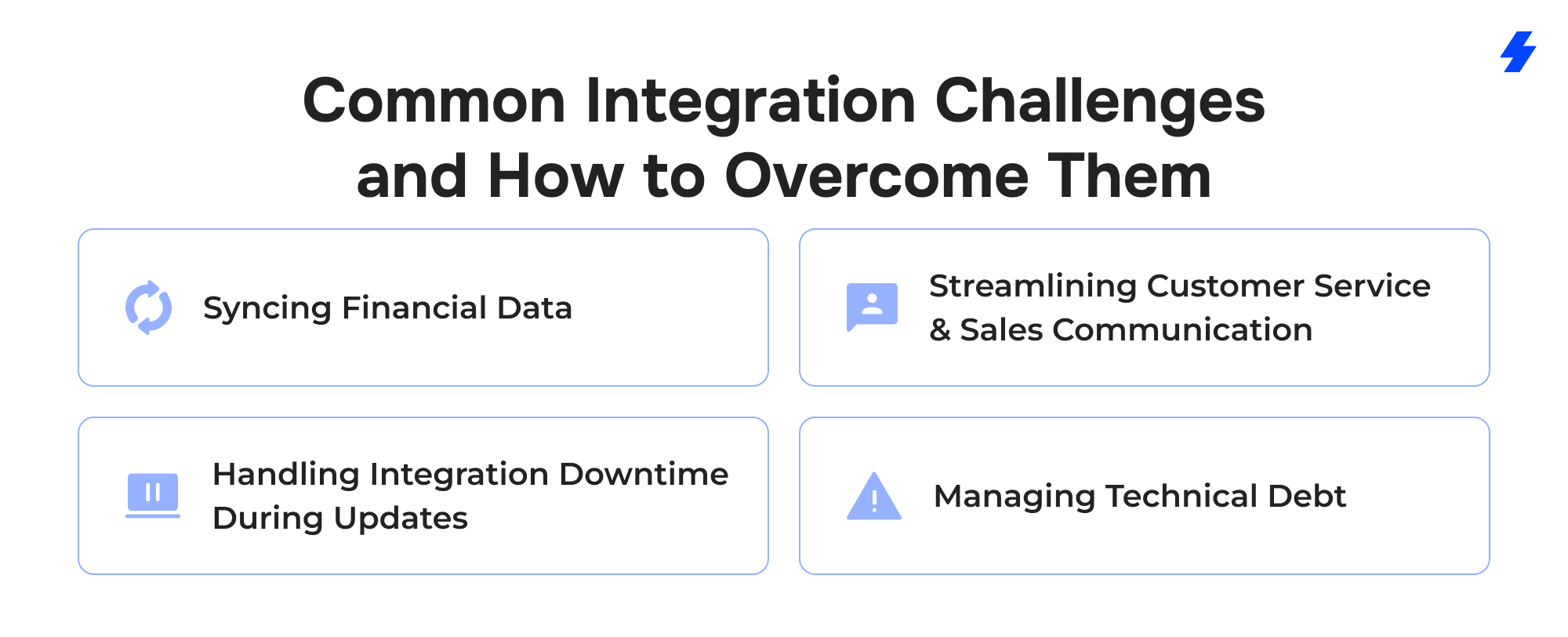
Syncing Financial Data
Integrating Salesforce with accounting tools like QuickBooks can be complex due to differences in data formats, transaction timing, and security requirements. Inaccurate or delayed syncs risk financial discrepancies, impacting invoicing and reporting. To overcome this, businesses should implement real-time or scheduled batch syncs with built-in validation rules and error alerts.
Utilizing middleware platforms that specialize in accounting integrations can also reduce complexity and improve data accuracy. Utilizing Salesforce Connect or AppExchange apps designed for accounting integrations can streamline this process.
Streamlining Customer Service and Sales Communication
Post-integration, teams may struggle with inconsistent data flow or duplicated efforts between customer service and sales. For example, case updates in Salesforce might not immediately reflect in Slack channels or support systems, delaying response times. A solution is to design event-driven integrations using platform events or webhook triggers, ensuring real-time updates and synchronized workflows that keep teams aligned.
Handling Integration Downtime During Updates
Salesforce releases updates three times a year, which can sometimes disrupt integrations if connectors or custom code are incompatible. To minimize downtime, establish robust testing environments and use automated regression testing before applying changes in production. Employing modular, API-led integration architectures helps isolate and quickly fix issues without halting the entire system.
Managing Technical Debt
Over time, integration layers can accumulate complexity, making maintenance costly and error-prone. To manage technical debt, regularly audit integrations for redundant workflows or outdated APIs. Adopt low-code/no-code platforms for easier updates, and document integration processes thoroughly. Investing in ongoing support with Salesforce consultants or dedicated integration specialists ensures sustainable performance and scalability.
Why Choose MagicFuse for Salesforce Integration?

- 100% Certified Team
Our entire engineering team holds Salesforce certifications, ensuring expert-level knowledge and proven skills to deliver reliable, high-quality solutions.
- 250+ Salesforce Certifications
With over 250 certifications earned, including recent ones like Experience Cloud Consultant, Data Cloud Consultant, B2B Solution Architect, AI Specialist, and more, we stay at the forefront of Salesforce innovations to meet your evolving needs.
- Customer-Facing Engineering Team
We believe in full transparency. Our clients have direct access to our engineers and resources, with no hidden layers, enabling smooth communication and collaborative problem-solving.
- Fast Recruitment & Strong Retention
We recruit top Salesforce experts quickly, averaging 6 weeks per hire, while maintaining strong employee retention of over 3 years to provide consistent expertise on your projects.
- Outstanding Client Satisfaction
Our commitment to quality is reflected in an impressive Net Promoter Score of 92%, showing that clients trust and recommend our services.
- Top AppExchange Rating
With a stellar 4.9-star rating on Salesforce AppExchange, we demonstrate consistent excellence and customer satisfaction in the Salesforce ecosystem.
Choose MagicFuse to unlock measurable ROI and transform your Salesforce platform into a unified, efficient ecosystem built for growth.
FAQs
What types of systems can Salesforce integrate with?
Salesforce can integrate with a wide range of systems through inbound integration, including accounting and billing tools (e.g., QuickBooks), project management apps (e.g., Jira, Asana), marketing automation platforms (e.g., Pardot, Marketo), eCommerce solutions (e.g., Shopify, Magento), and collaboration tools like Slack.
How do I ensure that my Salesforce integration is seamless and secure?
Seamless and secure integration requires thorough planning, using reliable middleware or APIs, enforcing data validation, and implementing authentication protocols like OAuth. Regular monitoring and updates also help maintain integration health and security.
What are the benefits of integrating Salesforce with accounting and billing systems like QuickBooks?
Integration automates invoice generation, improves data accuracy, accelerates billing cycles, reduces manual errors, and provides real-time financial insights, helping businesses streamline revenue management and improve cash flow.
Can MagicFuse help with complex Salesforce integrations, including ERP or eCommerce tools?
Yes. MagicFuse has extensive experience handling complex Salesforce integrations, including ERP systems and eCommerce platforms, ensuring scalable, secure, and tailored solutions that fit your business needs.
How do I track the success of my Salesforce integration post-implementation?
Track key metrics such as lead conversion rates, sales cycle duration, customer satisfaction scores, operational cost savings, data accuracy, and user adoption rates to measure the impact and optimize your integration over time.






